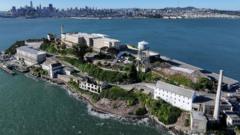Formerly a stronghold for infamous criminals, Alcatraz Island became a subject of renewed discussions when President Trump proposed its reopening as a prison during a recent address. Known for its harsh conditions and the storied escape attempts of prisoners like Al Capone and Frank Morris, the island, now a historical tourist site, may seem an unlikely candidate for modern incarceration.
The President’s remarks on Truth Social indicated his view that Alcatraz could serve as a beacon of "law and order," given rising crime rates. Despite this ambition, experts in the field of corrections quickly dismissed the idea as unattainable. Former Bureau of Prisons acting director Hugh Hurwitz noted the deteriorating state of the facility, stating, "It's not realistic to think you can repair it. You'd have to tear it up and start over."
Originally built to function as a military fortification, Alcatraz transitioned into a federal penitentiary in 1934. However, it was closed in 1963 due to exorbitant operational costs, nearly triple those of other prisons at the time. Presently, it serves as a significant tourist attraction, drawing over 1.4 million visitors annually, which presents a compelling case against its reallocation for imprisonment.
Trump's initial proposal revisits past considerations by other administrations, including Ronald Reagan, who briefly eyed Alcatraz as a refuge for Cuban refugees in the 1980s. Present advocates for the prison's revival, such as Trump's border czar Tom Homan, advocate for its potential use in handling threats to national and public safety.
Nevertheless, analysts point out logistical nightmares tied to its reopening. Concerns about infrastructure remain paramount: existing plumbing would need substantial work, and modern security enhancements such as surveillance systems are non-existent. John Martini, an Alcatraz historian, emphasizes that any revival would require significant financial investment not only in major repairs but also in basic utilities currently absent.
With Trump himself acknowledging the prison’s ruins as a "big hulk" of mixed history, the practicality of his proposal invites skepticism amid discussions of national security and public safety. As many experts suggest, reviving the mystique of Alcatraz may prove more feasible for storytelling than for reality.





















